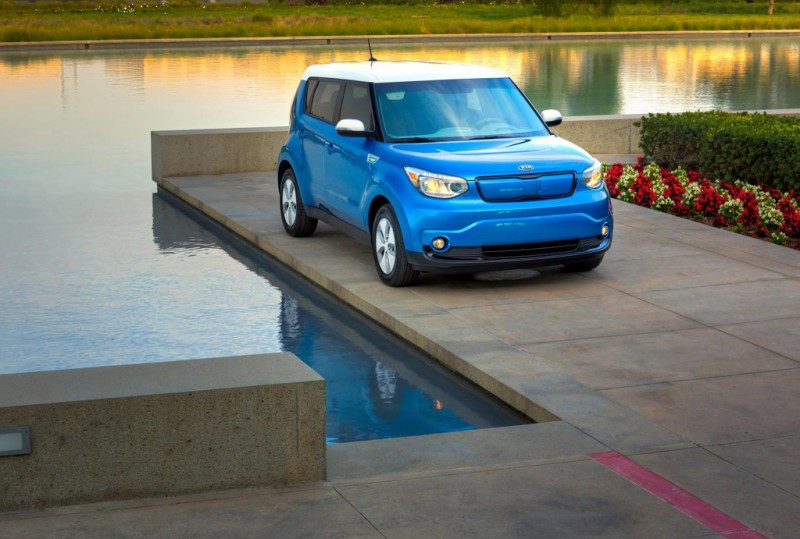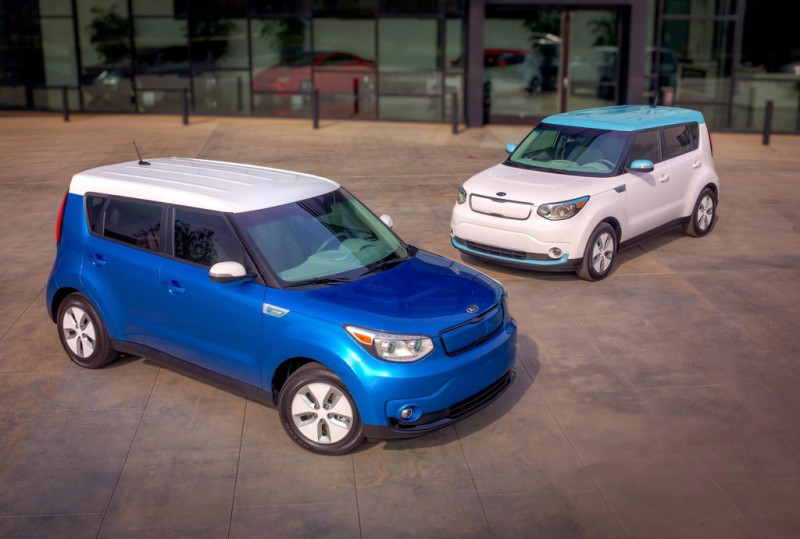Joining the ranks of other manufacturers keen to get a piece of the EV action, Kia Motors has taken the wraps off their first ever mass produced electric vehicle, the Soul EV and the Chicago Auto Show. The car is due to arrive in the UK after it goes on sale in both the United States and Europe in the third quarter of 2014.
The Soul EV was joined by the refreshed Kia Optima Hybrid which Kia hope shows their willingness to join in on the technologically advanced vehicle segment which tends to sway towards an environmental image too.
Kia’s eco-friendly commitment was further underscored when UL (Underwriters Laboratories) 2 honoured the Soul EV with the organization’s first automotive environmental validation for its integration of more than 20 bio-friendly materials.
High Energy Density Battery and Usable Power
The big question most EV buyers wonder is about range, and unfortunately Kia hasn’t pushed the envelope much further than anyone else in this department. The Kia Soul EV uses an energy-dense lithium-ion polymer battery which is positioned under the floor of the car. The 27kWh, air-cooled, 200 watt-hour/kg battery is expected to yield a range of approximately 80-100 miles of real-world driving on a full charge. So, it’s in the same realms as the Nissan LEAF and Ford Focus Electric but a little shy of the Renault ZOE’s range.
For the technically minded amongst you, Kia has released some core details about the Soul EV’s batteries which will whet the appetite of any electro-chemical lover.
The 360 volt 96-cell lithium-ion polymer battery has been engineered for high capacity, thermal stability and safety. Accordingly, the battery features a nickel-cobalt-manganese cathode, which helps increase capacity, and a graphite-based anode, which increases durability while reducing weight. Additionally, the cells use a gel electrolyte, and each cell contains ceramic separators to significantly improve thermal stability and safety.
Onboard the Kia Soul EV, there is the expected regenerative braking system which can capture up to 12% of the car’s kinetic energy, which is then fed back into the battery while the car is either coasting of braking. More in line with what the Volkswagen e-up! offers, though, is four different ‘regen’ modes, selectable by the driver. “Drive” or “Brakes” modes in Eco-mode “Off” and “Drive” or “Brakes” modes in Eco-mode “On” (the “Brakes” setting with Eco-mode “On” produces the most regeneration).
For charging, the Soul EV makes it easy by plugging into any standard 240v EV charger. Two charging ports are standard, including a SAE J1772 port for Level 1 and Level 2 AC, and a CHAdeMo DC fast-charging port (480v), meaning that you can make use of the 1,000 fast chargers around Europe. Found behind a sliding door located in the front grille, the dual ports offer flexibility and increase the Soul EV’s go-anywhere appeal, making it more convenient to charge inside the owner’s garage or when on the road. Recharging times vary from 24 hours for a fully depleted battery using a standard 120-volt outlet and under five hours when plugged into a 240-volt outlet. An 80-percent charge can be achieved in as little as 33 minutes with a 50 kW-output charger.
The front-wheel drive Soul EV is powered by an 81.4 kW, 109-hp electric motor, producing a generous 210 lb.-ft. of torque. The liquid-cooled AC synchronous permanent magnet motor uses multi-layer magnets to help improve efficiency and reduce the whine that’s commonly experienced with other electric vehicles.
The motor delivers its power to the front wheels through a single-speed constant-ratio gear reduction unit. Acceleration from 0-60 mph is expected to take fewer than 12 seconds with a top speed electronically limited to approximately 90 mph. Interestingly, additional cross bracing beneath the low-mounted battery contributes to a 5.9 percent improvement in torsional rigidity over the petrol or diesel-powered Souls.
Kia say that improved aerodynamics and the absence of engine noise, combined with special sound-proofing materials, result in an exceptionally quiet ride. For the benefit of pedestrian safety, the Soul EV is equipped with a Virtual Engine Sound System (VESS) that emits an auditory alert at speeds below 12 mph and whenever the car is in reverse, such as you might find on a Renault ZOE equipped with similar technology.
Minimal Battery Intrusion
Because of the battery’s flat design and location, there is a 3.1-inch reduction to rear seat leg room (from 39.1 to 36 inches) from the non-EV Soul, yet, Kia are keen to point out, the Soul EV offers more rear leg room than other key EV competitors of similar size. Rear shoulder and hip room remain unchanged from the petrol and diesel-powered Souls, making Soul EV one of the roomiest in the segment. Rear luggage space is minimally impacted too (reduced 5.1 cubic ft. to 19.1) as the space under the boot floor is used for the battery cooling fan and storage of the standard charger.
Uniquely Designed Inside and Out
Initially, the Soul EV will be offered in three colour choices: Pearl White lower body with Electronic Blue roof, Caribbean Blue lower body with Clear White roof, and Bright Silver with Clear White roof. The signature two-tone paint theme is exclusive to the EV and was inspired by a similar treatment seen on the Track’ster concept car.
The EV-exclusive front-end features a larger grille to accommodate the charging ports, and other unique exterior Soul EV design features include colour accent trim in the front and rear panels, projector headlights, LED positioning lamps, and LED tail lights. “Eco Electric” badging replaces the “Soul” badging found on the diesel and petrol-powered cars, and the Soul EV gets its own set of distinctive 16-inch alloy wheels wrapped with specially engineered Super Low Rolling Resistance (SLRR) tires that offer 10 percent less resistance than standard low rolling resistance tyres, helping to improve range.
Source; Kia


